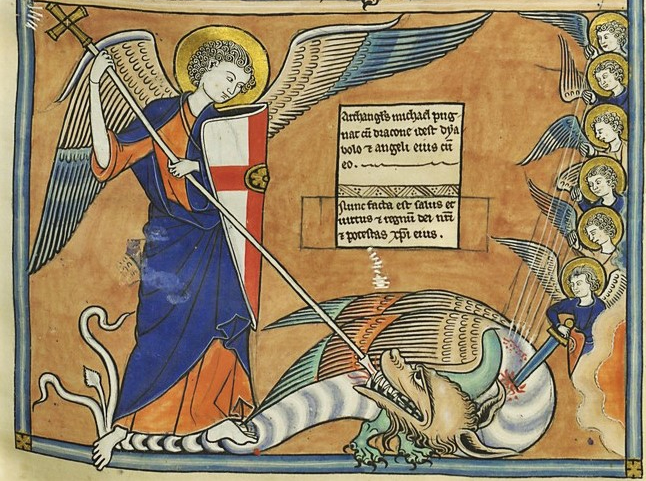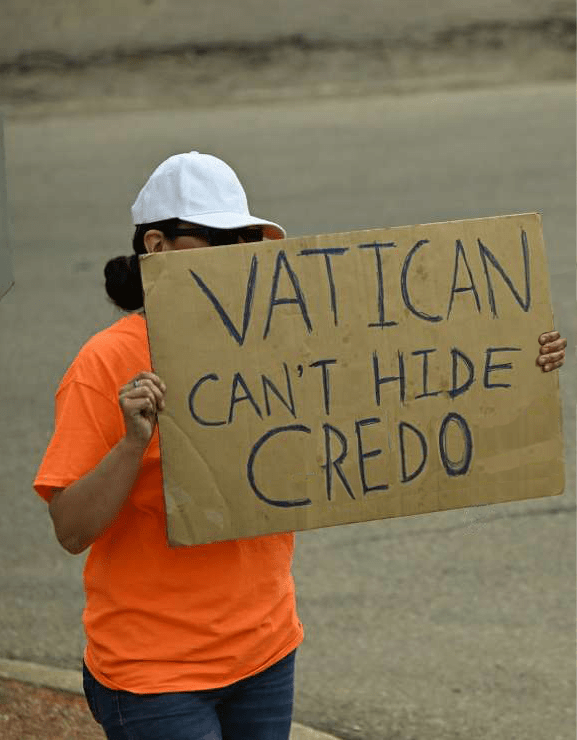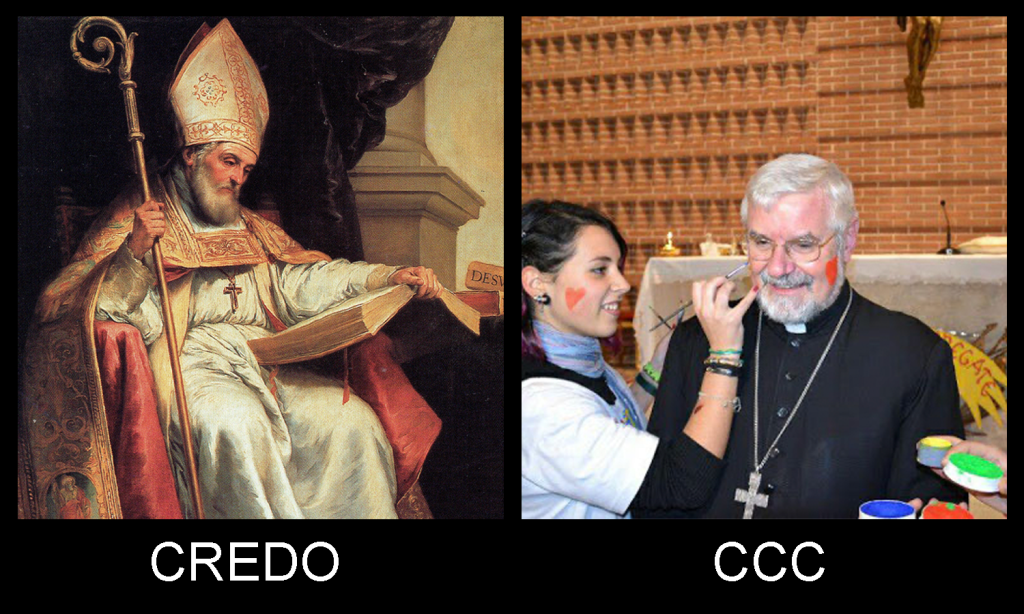DISCLAIMER: A number of us at WOR fundamentally disagree with Bishop Athanasius Schneider’s approach to the current Vatican Nightmare, which essentially amounts to: “wait and pray.” Surely, St. Paul was not content to do as much when St. Peter was scandalizing the faithful, so we may hope for a bit more from the bishops of our time.
*Blessedly, what follows is quite a bit more. Deo Gratias.

Happy Michaelmas! A day for good tidings.
As others have pointed out over the years, amidst the present Catholic Brand War (“This is Catholic doctrine!” “No, that is Catholic doctrine!”), there is one public, canonical action within reach of any local ordinary, at any time, yet which has been hitherto left unattempted by individual hierarchs since Vatican II.
That action is issuing a solid catechism, as an exercise of the ordinary magisterium, reasserting the common and received doctrine of the Church.
Well, lo and behold: Bishop Athanasius Schneider has done it.

Yes, this is the manuscript previously reported on here.
Yes, this is a catechism for our times, issued under imprimatur and endorsed by additional bishops — Cd. Sarah and Bp. Strickland among them.
Yes, the content approaches miraculous. See for yourself: scroll down at the launch page here to “look inside.”
There’s too much to unpack at present. Suffice it to say that one finds here a full-bore, systematic walk-through on Catholic faith and morals from a traditional framework, with an eye to applying the Church’s classical doctrine to contemporary issues, even the most contested.
An alternate news headline could easily read: “Bishops Ignore AntiChurch Synod of Doom, Publish Excellent Catechism Instead.”
In sum, Credo is a clear-eyed, single-volume, and reliably Catholic answer to the question: “What does the Church really teach about xyz, and how do we live it out today?”
So, Who Cares?
Those who risk yawning off “just another bishop book” shouldn’t miss the true significance here. As with Cd. Robert Bellarmine’s catechism, issued in the midst of widespread hierarchical corruption some five centuries ago, no mere book will fix our ecclesiastical woes. Rather, Credo will serve another aim, and brilliantly: Witness. Perdurance.

Truth never goes quietly.
As one of our readers pointed out previously, whatever this book “achieves” with regard to the Vatican Nightmare today or tomorrow, we dwell on its deeper meaning at the present: for, Credo relitigates every doctrinal deviation of Vatican II, and about every other error taught by clerics since then. This means that a Roman prelate has affirmed the traditional apostolic doctrine in a public, canonical, authoritative mode — indeed, in the very face of AntiChurch forces everywhere — and with episcopal support.
It means the historical record is now set. It means the torch of divine Truth has been relayed in our days. It means the Faith is once more held up, like an indestructible monument on a mountaintop. It means Hard Evidence that the narrative of AntiChurch is exploded: there are no “many ways of being Church,” no “big tent Catholicism” shared by heretics, schismatics, pagans, and faithful alike. There is no middle. There is Catholic, and there is not Catholic.
It means true and false. It means victory.
And, just think: AntiChurch forces cannot afford to even mention this book. To affirm it would be to reveal the doctrinal errors of the past sixty years. To condemn it will require the formal affirmation of some doctrinal error. To slander or quietly relocate the author — or send him a little “canonical visitation” — will only lend weight to his words. But to say nothing will be a tacit affirmation of his teaching, seeing as it comes from the ordinary magisterium of Catholic bishops: only highlighting the Brand War.
The only viable alternative for AntiChurch would seem to be silence…
…but, that will prove awfully difficult, as the publisher informs us that Credo will be launched internationally in Rome this October — indeed, as a “response to the call of the Synod!” Masterful.

Let the Memes Begin
Now, given the clarity and simplicity of so many doctrinal points in Credo (you just have to love Question–Answer format), we suspect that this book will do more to highlight the Catholic Brand War than anything hitherto in print. After all, these bishops say this is Catholic doctrine; so, does every bishop agree? Since when? Why not? Says who?
Indeed, nearly every sentence in Credo lends itself to the art of the “meme,” and emphasizes the stark contrast of countless positions and practices that pass for “Catholic” today. Imagine the kind of “this vs. that” memes yet to come, stacking Credo propositions against things written by the hierarchy since the 1960s — to say nothing of the upcoming Synodal nonsense.
We’ll try our hand at a few:




And because of the inevitable “Credo vs. Catechism of the Catholic Church” comparisons that are sure to appear in coming days — a veritable Clash of the Catechisms, one might say — we’ll take a first crack at it:

What, can’t we poke a few holes in (the most recent iteration of) the Incredible Melting Catechism? Never mind the CCC’s Supremely Merciful Death Penalty Update™; try this comparison with Credo on another of its major points:
Christ’s Spirit uses these Churches and ecclesial communities [i.e., schismatic and heretical sects] as means of salvation.
CCC, n. 819
VS.
Is it proper to affirm that the Spirit of Christ uses separated Christian communities as “means of salvation”?… No. This insinuates a quasi-legitimacy for separated Christian communities, undermining the unicity of the Catholic Church and promoting doctrinal relativism. In truth, God willed and established the Catholic Church as His unique Church and possessor of the means of salvation. The diversity of separated Christian communities is therefore contrary to Christ’s intention, as is the diversity of world religions.
Credo, p. 84
Are the above propositions mutually exclusive? Does it matter?
The point is, there are scores of statements in Credo that accord beautifully with everything taught in catechisms predating 1962… but which simply don’t jive with things taught elsewhere (including in the CCC) since then.
Now it’s your turn, WOR readers!
Join the fun by posting your own Credo meme in a comment, or by sending us a message, and we will host a “meme roundup” post in days to come.
Deo Gratias…
…and Bravo the Restoration!
Let the reader understand — with this book, the revolutionaries’ script since the 1960s has entirely flipped: “It says right here, THIS is the Church’s teaching. What, didn’t you know that? Get with the program!”
LikeLike